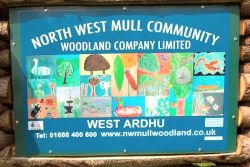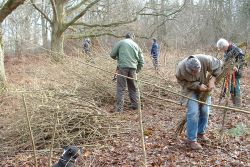Summary
 Photo courtesy Michelle Cowe
Photo courtesy Michelle Cowe
Updates
January 2014 : a new study commissioned by Forest Research highlights the role of local authorities in England, in woodland management, community woodlands and social enterprises. See the Shared Assets (PDF-2343K)report for more information.
 August 2013: Our new Research Note is published. “A framework for sharing experiences of community woodland groups” provides an overview of evidence on community woodlands, and a new tested method for describing case studies. Thanks to the Silvanus Trust and the Community Woodland Association for testing it – see below!
August 2013: Our new Research Note is published. “A framework for sharing experiences of community woodland groups” provides an overview of evidence on community woodlands, and a new tested method for describing case studies. Thanks to the Silvanus Trust and the Community Woodland Association for testing it – see below!
Photo courtesy Richard Snow
March 2013: Two experienced organisations were com missioned to test out our framework through applying it to a set of case studies in Scotland and SW England.
Details and reports
Summary
What is community forestry?
Community forestry is evolving in Great Britain across a variety of social and environmental contexts. The forest strategies of England, Scotland and Wales all have aims that can be addressed through community forestry. However different models, experiences and discourses have evolved in the different contexts:
- In England ‘community forestry’ often refers to management of new and existing woodland in areas of urban regeneration for public benefit.
- Social activism and policy changes in Scotland have led to a twofold model of urban regeneration, and community ownership and enterprise in rural areas.
- In Wales community forestry has developed through efforts led by rural communities and project funding, with results now incorporated into the revised Woodland for Wales strategy.
What this project is setting out to do
This project sets out to understand the range of meanings, experiences and impacts of community forestry in Great Britain.
Beginning in 2008, this project has taken an exploratory approach aiming to document the perspectives and experiences of the many different stakeholders in this arena. In 2008 it was built on opportunities to respond to particular interests and needs of partners. In 2009 it continues with activities that aim to synthesise findings and produce a framework for understanding the usefulness of different models.
This work links closely to other social research at Forest Research, on the meanings, experiences and outcomes of partnership and engagement; and on the role of woodlands in community or social enterprise.
Brief research summary (PDF-160K)
Includes background, objectives, methods, findings and recommendations.
Research objectives
- To understand the range of experiences, meanings and outcomes of community forestry in Scotland, Wales and England
- To document corporate memory within the Forestry Commission and its partners
- To compare experiences in different contexts, and develop models that link outcomes to context
- To disseminate key findings and guidance on models for successful community woodlands.
Project outputs 2008-2011
A policy seminar: What does community forestry mean in a devolved Great Britain?
Speakers examined the current practice of community forestry in GB within the policy contexts of the different countries, addressing questions such as the different meanings of community forestry and its role in changing governance. The speakers were Bob Frost, Community Development Policy Advisor, Forestry Commission Scotland; Barbara Anglezarke, Cydcoed Programme Manager, Forestry Commission Wales; Paul Nolan, Director, The Mersey Forest, England.
This was hosted by the Biennial Conference of the International Association for the Study of the Commons, in Cheltenham in July 2008. The seminar was summarised in a paper published in International Forestry Review:
- What does community forestry mean in a devolved Great Britain? (PDF-688K).
International Forestry Review. Vol. 11(2). 2009.
A review of the community benefits of the National Forest Land Scheme for Forestry Commission Scotland
This provided the opportunity for a detailed study of the experiences of members of two Highland communities who have purchase forest land from Forestry Commission Scotland in this land reform programme:
- Community experiences of the National Forest Land Scheme (PDF-405K)
- Two page summary of National Forest Land Scheme report (PDF-713K)
Short commissioned papers from individuals and organisations working in each of England, Wales and Scotland
These provide a ‘state-of-the-art’ outline of current developments in community woodlands and forests, focusing particularly on the range of emerging models, and organisational development, to complement the experiences of the Forestry Commission and Community Forests:
- Community forestry in Scotland (PDF-1868K)
- Community woodlands in England (PDF-290K)
- Community woodland baseline report: Wales (PDF-908K)
The reports are first attempts to document the diversity of community woodlands in each country. We welcome feedback and additional information. Please contact Anna Lawrence.
A follow-on report provides more detail about the character and support needs of community woodland groups in England:
For feedback or additional information on this study please contact Bianca Ambrose-Oji.
Note: The reports above have been commissioned by Forest Research, but the views and opinions expressed within them remain those of the organisations which produced them.
Forest restoration: understanding the effects of community forestry in Great Britain
A paper presented at the 18th Commonwealth Forestry Conference with the theme of “Restoring the Commonwealth’s Forests: Tackling Climate Change” which took place in Edinburgh, UK from 28th June to 2nd July 2010. The Conference explored the numerous challenges facing forests and society, together with some of the opportunities to address them. The paper looks at community engagement in practice and explores the contribution of community woodlands and forests to forest restoration in Great Britain. It shows that there has been is a shift of focus from biophysical (tree planting) to including social impact in restoration objectives, but monitoring and evaluation still focuses on outputs rather than their longer term and wider restoration effects. Qualitative evidence for empowerment and enhanced community cohesion and creativity suggests a wider range of intangible benefits. It is concluded that revival of community engagement with woodlands constitutes an important component of forest restoration which should be assessed as an opportunity to shape future restoration.
Understanding the effects of community woodlands and forests in Great Britain
Civil society, communities and woodlands: emerging opportunities
Circumstances are evolving fast for community groups and other civil society organisations looking to involve themselves in forest and woodland management and ownership.
A workshop was held in February 2011 to take stock of experience across all three countries, exchange lessons and look towards the future. Civil society groups and other participants from England, Wales and Scotland, identified emerging opportunities and distilled some key messages for decision makers.
Further consultations and discussions including community woodland groups in England canvassing view about the future have been hosted by Small Woods in Spring 2012 and most recently in January 2013. The January 2013 workshop report (below) provides more evidence about the opportunities and barriers experienced by this sector, and documents potential ways forward including the formation of local and national associations.
Community woodlands and Community woodland groups in England: Sustainability, networking and voice (PDF-220K)
Community connections: International models of community forestry
History, society, politics and economics both limit and open up options for community forestry. The article below for Chartered Forester magazine looks at the conditions under which different models of community forestry have developed in different parts of the world, and examines the associated policy opportunities, woodland management decisions, the knowledge and learning generated, ending with lessons for the UK.
Community connection (PDF-645K)
This article first appeared in Chartered Forester (Spring 2011), the quarterly magazine for members of the Institute of Chartered Foresters.
Future outputs
- A discussion paper to present issues and options around alternative models of community forestry, drawing particularly on experiences from continental Europe and North America.
Funders and partners
![]()
![]()
![]()


This research is part of the current social research programme of Forest Research funded by the Forestry Commission. The study of the National Forest Land Scheme was also part-funded by Forestry Commission Scotland.
The research is led by Anna Lawrence of Forest Research. Since 2009 it is co-led by Bianca Ambrose-Oji.
Reports have also been written by staff from the Small Woods Association, Forestry Commission Scotland and the Mersey Forest. Amanda Calvert, Alzena Wilmot and Katy Harris have collaborated as independent researchers.
Forestry Commission policy
The Scottish Forestry Strategy aims for three high level outcomes, including OUTCOME 1: Improved health and well-being of people and their communities. This is to be achieved largely through KEY THEME 4: Community development, including (amongst other purposes) ‘Support community ownership and management on the national forest estate, where this will bring increased benefits.’
The England Trees Woods and Forests strategy makes numerous references to community, and the Community Forests. The Communities and Places theme has a focus on ‘cohesive and engaged communities’. Particularly relevant are the policies to ‘help people to engage with the ownership, design, management, maintenance and use of their local trees and woodlands as part of their vision for their own neighbourhood (especially those groups and individuals who are difficult to reach or not currently involved)’ and ‘promote and support the role of trees and woodlands as a catalyst for community capacity building’
The Woodlands for People theme of Woodlands for Wales includes the statement: ‘We want to make sure that the woodlands of Wales, especially those we own, are managed in a way that supports local communities, including the most disadvantaged and minority or hard to reach groups.’ A strategic outcome of woodlands for people is: ‘More communities benefit from woodlands and trees, as a result of closer involvement in decision-making and management of woodlands at a community level.’
Status
2008 to 2011.
